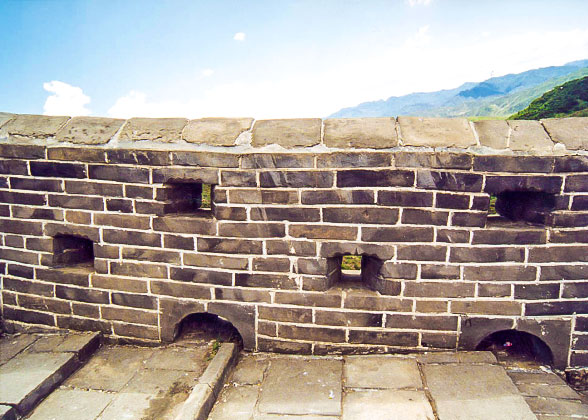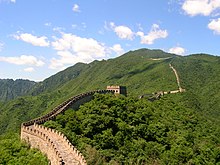Great Wall of China
万里长城UNESCO World Heritage Site The
Great Wall of China is a series of
fortifications made of stone, brick,
tamped earth, wood, and other materials, generally built along an east-to-west line across the historical northern borders of
China in part to protect the Chinese Empire or its prototypical states against intrusions by various nomadic groups or military incursions by various warlike peoples or forces. Several walls were being built as early as the 7th century BC;
these, later joined together and made bigger, stronger, and unified are now collectively referred to as the Great Wall.
Especially famous is the wall built between 220–206 BC by the first
Emperor of China,
Qin Shi Huang. Little of that wall remains. Since then, the Great Wall has on and off been rebuilt, maintained, and enhanced; the majority of the existing wall was reconstructed during the
Ming Dynasty.
Other purposes of the Great Wall have included border controls, allowing the imposition of duties on goods transported along the Silk Road, regulation or encouragement of trade and the control of immigration and emigration. Furthermore, the defensive characteristics of the Great Wall were enhanced by the construction of watch towers, troop barracks, garrison stations, signaling capabilities through the means of smoke or fire, and the fact that the path of the Great Wall also served as a transportation corridor
The Great Wall stretches from
Shanhaiguan in the east, to
Lop Lake in the west, along an arc that roughly delineates the southern edge of
Inner Mongolia. A comprehensive archaeological survey, using advanced technologies, has concluded that the Ming walls measure 8,850 km (5,500 mi).
This is made up of 6,259 km (3,889 mi) sections of actual wall, 359 km (223 mi) of trenches and 2,232 km (1,387 mi) of natural defensive barriers such as hills and rivers.
Another archaeological survey found that the entire wall with all of its branches measure out to be 21,196 km (13,171 mi).
Who, When and Why Built the Great Wall of China?
Who built the Great Wall? There are many answers. Some say Emperor Qin Shihuang. Some say ordinary working people of ancient China, and some say that it was slaves who built the wall. This is not an easy question to answer, just like the wall was not easy to build.

Experts have given us the most credible answer. As early as the Warring States Periods (476 BC - 221 BC), the ruling powers began to build walls as a defense against the northern nomadic tribes and other potential enemies. The state of Chu (11th Century BC-223BC) was the first to build a wall, followed by the Qi, Yan, Wei, Zhao and Qin. After Emperor Qin Shihuang unified the six states, he ordered General Meng Tian to connect the existing walls and to extend them further as a front line defense against possible invasion. Thus the Great Wall of China was formed. It extended from Lintao (present Lintao County in Dingxi City in Gansu Province) in the west and ended at Liaodong (present the eastern and southern parts of Liaoning Province) in the east. It was called "Wan Li Chang Cheng" (The Long Wall of 10,000 Li).
Three groups of people built the wall. They were soldiers, common people and criminals. Many people died during its construction, due to the heavy work, short time limit and tough condition. An accurate number of those who died is unknown.
During subsequent dynasties, the wall was extended, repaired or modified. The section of wall built in Han Dynasty (206BC-220) is the longest. During the Ming Dynasty (1368-1644), the wall was substantially repaired on more than twenty occasions. Today, the best known and most visited sections of the wall are at Badaling, Mutianyu, Simatai and Jinshanling and these were built in the Ming Dynasty. They were all built to protect the people and territories south of the wall from a continued threat of invasion by the northern nomadic tribes.
Can the Great Wall Be Seen from the Space?
Measuring about 8,851.8 km (5,500 miles) long, the Great Wall is no doubt the longest manmade project on the earth. It was once widely believed that it can be seen from the space. Many astronauts have verified this saying and taken photos as evidence. Some medium even reported with affected seriousness, "The biggest building the astronauts could see from the space is the Great Wall, which looks very much like a black worm." Consequently, this statement has gone deep into people's minds and become a great honor that Chinese people enjoyed for years.
Is the Great Wall truly visible from the moon? Yang Liwei, China's first astronaut who was lifted into the outer space by the spacecraft Shenzhou V on Oct.15, 2003, gave a definite answer "No" to a reporter after he reached the ground. Yang's negative response in a practical way may probably put out a fair number of people's passion. But it powerfully corrected the misconception. Great Wall is indeed great, but you won't see it from the space!
In fact, besides Yang Liwei, there are a lot of astronauts said the Wall could not be seen from the space. Neil Alden Armstrong, the American aviator who first set foot on the moon in 1969, was asked a thousand times whether or not he had seen the Great Wall from the moon. Recently from a sound recording that announced by NASA Johnson Space Center, Armstrong said that he had seen the continent, lakes and blue spots touched with red. But he could not make out any manmade object on the earth from the moon
Great Wall Sections:
The Wall we see today was mostly built during the Ming Dynasty (1368 - 1644). It starts from Hushan in the east to Jiayuguan Pass in the west traversing Liaoning, Hebei, Beijing, Tianjin, Shanxi, Inner Mongolia, Ningxia, Shaanxi, Gansu and Qinghai. Here lists the famous sections for you to know the incredible diversity of scenery along the wall and practical travel tips.
 Badaling Badaling |  Gubeikou Gubeikou |  Huanghuacheng Huanghuacheng |
 Huangyaguan Huangyaguan |  Jiankou Jiankou |  Jiayuguan Jiayuguan |
 Jinshanling Jinshanling |  Juyongguan Juyongguan |  Mutianyu Mutianyu |
 Shanhaiguan Shanhaiguan |  Simatai Simatai |  Yangguan Yangguan |
 Yanmenguan Yanmenguan |  Yumenguan Yumenguan |  Zhenbeitai Zhenbeitai |
Great Wall History
The history of the Great Wall is said to start from the Spring and Autumn Periods when seven powerful states appeared at the same time. In order to defend themselves, they all built walls and stationed troops on the borders. At that time, the total length of the wall had already reached 3,107 miles, belonging to different states.
In 221 BC, the Emperor Qin absorbed the other six states and set up the first unified kingdom in Chinese history. In order to strengthen his newly born authority and defend the Huns in the north, he ordered connecting the walls once built by the other states as well as adding some sections of his own. Thus was formed the long Qin's Great Wall which started from the east of today's Liaoning Province and ended at Lintao, Gansu Province.
In the Western Han Dynasty, the Huns became more powerful. The Han court started to build more walls on a larger scale in order to consolidate the frontier. In the west, the wall along the Hexi corridor, Yumenguan Pass, and Yangguan Pass was built. In the north, Yanmenguan Pass and Niangziguan Pass in Shanxi were set up. Many more sections of the wall extended to Yinshan Mountain and half of the ancient Silk Road was along the Han's wall.
The Northern Wei, Northern Qi and Northern Zhou Dynasties all built their own sections but on a smaller scale than the walls in the Han Dynasty. The powerful Tang Dynasty saw peace between the northern tribes and central China most of the time, so few Great Wall sections were built in this period.
Great Wall Construction
The history of the construction of the Great Wall of China can be dated back to the Western Zhou Dynasty (11th century BC - 771 BC). But the Great Wall at that time was only a line of fortresses standing to defend against attacks from the Yanyun (an ancient nomadic tribe in north China). The Period of the Warring States (476 BC - 221 BC) was an era when the seven states (Qi, Chu, Yan, Han, Zhao, Wei, Qin) were busy engaging in Great Wall construction for self-defense. Instead of one line, their walls stretched in the four directions and varied in length from several hundred miles to one or two thousand miles.
In the Qin Dynasty (221 - 206 BC) the emperor Qin Shihuang ordered his laborers to connect these scattered walls and create some new sections, thus forming a Great Wall in northern and central China in the true sense. The Ming Dynasty (1368 - 1644) further developed the defensive system of the wall and strengthened it on a larger scale. It pushed the wall construction to its highest peak.
 |
| Battlement Wall with Loopholes |
The winding Great Wall is not merely a wall but instead a complete and rigorous defense project composed of countless passes, watchtowers, garrison towns, beacon towers and blockhouses. These fortifications were arranged in certain ways under the control of the military command system at all levels. For example, there were about 1,000,000 soldiers guarding the Ming's Great Wall. The chief military officers were stationed in garrison-towns, while lesser officials and soldiers were stationed in Guan Cheng (the defensive beachhead) and other smaller fortifications. The eleven
Great Wall garrisons were set up along the Great Wall in order to guard the precinct or subsection.
The average height of the Ming Great Wall measures 33 feet and the width is about five yards. In low, flat areas the Great Wall was built high and more defense lines were added. In the lofty mountains, the wall was a little lower in order to save the human and financial cost. Sometimes, even steep cliffs served as natural walls to thwart enemies.
Today, the Great Wall has lost its military function, but as a great ancient engineering work, its magnificent beauty and austere structure are still worthy appreciating.
Great Wall of China
万里长城 |
|---|

The Great Wall |
Map of all the wall constructions |
| General information |
|---|
| Type | Fortification |
|---|
| Country |  China China |
|---|
| Coordinates | 40.67693°N 117.23193°ECoordinates: 40.67693°N 117.23193°E |
|---|
| Construction started | 7th century BC |
|---|
| Technical details |
|---|
| Size | 21,196 km (13,171 mi) |
|---|
|
UNESCO World Heritage Site |
| Official name: The Great Wall |
| Type: | Cultural |
|---|
| Criteria: | i, ii, iii, iv, vi |
|---|
| Designated: | 1987 (11th session) |
|---|
| Reference #: | 438 |
|---|
| State Party: | China |
|---|
| Region: | Asia-Pacific |
|---|
































